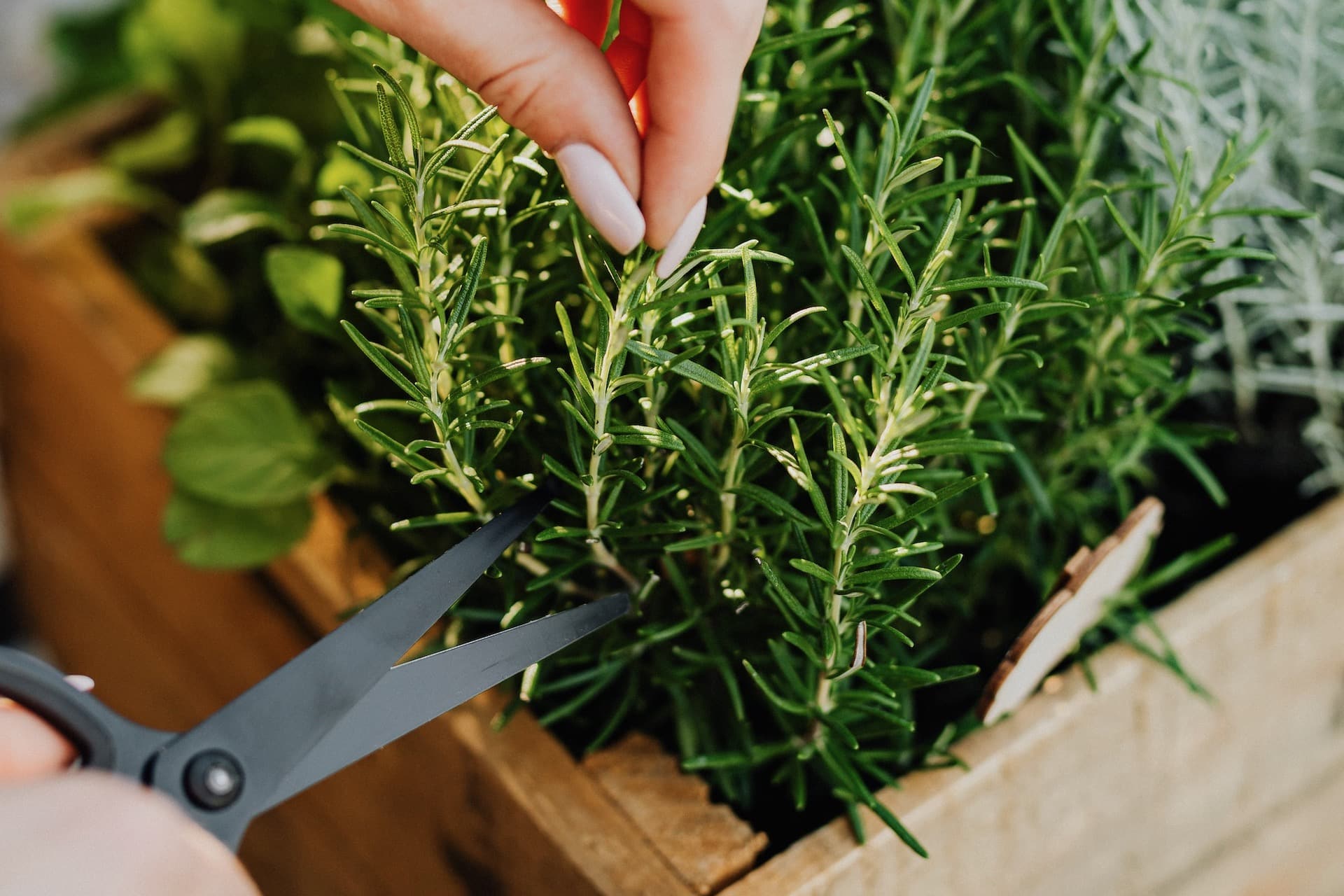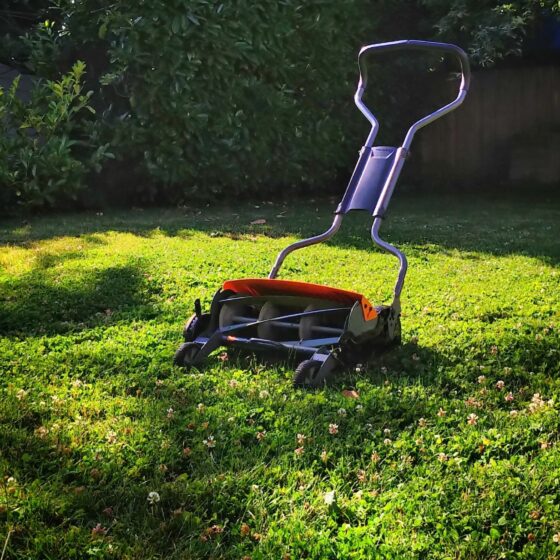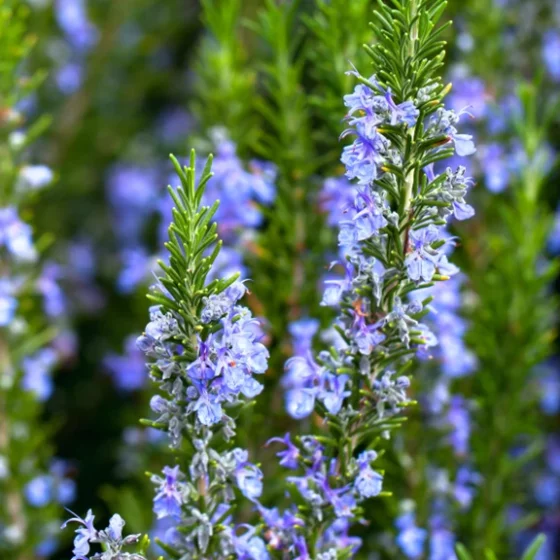Do you love the smell of rosemary? This fragrant herb is a great addition to any dish, and the best thing is — you can grow it yourself. However, rosemary is notoriously famous as difficult to grow indoors.
But fret not! In this thorough guide, we’ll teach you how to grow rosemary indoors successfully and enjoy its refreshing taste all year round.
So, buckle up, and let’s start!
How Hard Is It to Grow Rosemary?
Unlike delicious jalapeño peppers (and various other spices and herbs), rosemary can be challenging to grow.
To illustrate, only 30%–50% of the rosemary seeds you plant will develop into seedlings. So, if you plan to grow rosemary from seeds, make sure you get a good amount of them to increase your chances of success.
And when you plant the seeds, you’ll have to arm yourself with patience, as you’ll have to wait up to three months to see the first sprouts. This is why novice and avid gardeners alike usually opt to propagate rosemary from stem cuttings (sprigs) or nursery plants.
How to Grow a Rosemary Plant From Stem Cuttings
The easiest way to grow rosemary is from stem cuttings.
So, the first thing you should do is get yourself some rosemary sprigs.

If some of your friends have a mature rosemary bush, they might be willing to give you some cuttings, and if not, store-bought fresh rosemary sprigs will work just fine. Ideally, the sprigs should be 4–8 inches long and cut at a 45-degree angle.
As explained in our detailed guide on rosemary propagation, the best time to collect stem cuttings is when the temperatures drop (early fall) and the stems develop woodier ends.
Once you get the sprigs, you should strip the leaves off the bottom end (at least two inches on the bottom should be bare, and this is where roots will sprout from).
The next step will depend on whether you want to use rooting powder or not:
How to Grow Rosemary in Pots (the Rooting Hormone Way)
If you want to improve the likelihood of your cuttings growing roots, you can use rooting hormone powder:
- Fill a small pot (3–4 inches) with potting soil. The pot should have drainage holes.
- Dip the rosemary sprigs in some water and then in the rooting hormone powder.
- Plant the cuttings in the pot.
- Lightly spray the cuttings with water.
- To keep the humidity levels optimal and give the plant all the warmth it needs, put a transparent plastic bag over the plant and the pot. Puncture the bag in a couple of places to get the air coming in and secure the bag at the bottom.
- Place the pot near (but not directly in front of) a bright window.
- The sprigs should grow roots in several weeks (you’ll know whether your rosemary will survive in four to eight weeks).
- Once they do, repot each cutting in a separate four-inch pot.
But remember — if you do decide to do this, you’ll have to wait for a whole year for it to become safe to consume the rosemary leaves. This is how long it takes rooting hormones, which can be harmful to humans, to “wear off.”
How to Grow Rosemary in Water (the Rooting Hormone-Free Way)

Though rooting powder may help your rosemary plant develop stronger and healthier roots, using it isn’t obligatory. If you want to avoid waiting for a year to consume your rosemary plant and be able to see the whole propagation process, propagate rosemary in water:
- Place rosemary cuttings in a clean glass or any other clear container.
- Add enough fresh water to cover two bottom inches of the stems (make sure no leaves are submerged to prevent them from rotting and contaminating the water).
- Change water every couple of days to keep it fresh and clean.
- Wait for the roots to appear (you can expect to see roots in about a month).
- Once the root system has developed (you should have four to six roots about 0.5 inches long), you can transfer the cuttings to pots.
How to Grow Rosemary From Seeds
Planting rosemary seeds is quite easy but rarely a big success.
Here’s what you need to do to improve your chances:
- Get the right potting soil. Rosemary seeds require a well-drained potting mix like sand, bark, pearlite, or vermiculite to sprout.
- Plant at least three seeds per container three months prior to summer (ideally in the middle of the winter).
- Place the seeds on top of the potting mix and lightly cover them with more potting mix.
- Sprinkle some water on top to fix the seeds in their place.
- Put a plastic bag or wrap on top of the container to maintain the warmth and moisture necessary for successful germination.
- Place the containers in a warm place inside your home.
- Once the seeds start to germinate, take off the plastic cover.
And most importantly, keep your expectations in check.
As we already mentioned, rosemary seeds take a while to germinate, and most of them won’t germinate at all (you may expect only about 30%–50% of your seeds to sprout).
How Much Space Does Rosemary Need to Grow?
Rosemary is a tall plant, and when grown outside, in a garden, it can reach a height of six feet.
It doesn’t grow much shorter if you plant it in a pot, either. Namely, it can grow to anywhere between two and six feet, depending on the variety. The shrubs can also get four to five feet wide.
Despite their impressive size, rosemary shrubs don’t need abundant space to grow. And they don’t mind growing next to one another. Still, you should avoid overcrowding them — you should place your rosemary seeds or starter plants about two to three feet apart.
To make sure it’s got enough space to adequately develop, repot your rosemary once a year (at the start of the growing season) and make sure the new pot is large enough. Also, trim the shrub regularly to prevent the branches from growing too big.
How Long Does It Take to Grow Potted Rosemary?
Rosemary is a slow grower, and you’ll just have to accept that. You’ll need to be patient for at least six weeks (sometimes even up to eight) for the first signs of growth to appear.
Indoors, rosemaries need several years before they reach full maturity, but luckily, you can harvest them much sooner — 80–100 days after planting.
It’s best to wait for several eight-inch branches to form before starting to harvest your rosemary shrub. Then, you can snip as much as one-fourth of the plant for your meals.
Rosemary Plant Care Indoors
You’ve successfully germinated/rooted your rosemary plant? Congratulations! You’ll be thrilled to find out that once sprouted, rosemaries don’t need much to be happy indoors.
A sunny window, a well-aerated draining potting mix, and some water are basically all they need to thrive.
Let’s check out the details!
Rosemary Light Requirements
Like many Mediterranean plants, rosemary doesn’t like shade. It needs at least six hours of direct sunlight per day, preferably more. So, to make your rosemary thrive indoors, place it near a sunny window.
Humidity Requirements
Rosemary plants thrive in environments with medium humidity. So, keep the humidity levels at 45%– 55%. This is also (more or less) the optimal humidity for humans!
If you believe you’re below this mark, mist the plant lightly at least once a day.
Another thing you can do to make your rosemary thrive is to put some water in the drainage pan together with some rocks. This will allow your plant to absorb the humidity from the air as the water evaporates.
Temperature Requirements
If you live in an area where the temperature doesn’t drop below 30 °F during winter, you can grow your rosemary outside all year long. If this isn’t the case, your rosemary might be better off indoors.
Rosemaries are warmth-loving plants and prefer temperatures between 55 °F and 80 °F during the growing season. They also like warm winters with day temperatures of 60 °F to 65 °F and night temperatures of 40 °F to 50 °F.
Watering Requirements
Unlike orchids, which need watering once a week, rosemary likes it on the drier side.
If you’ve been wondering how often to water rosemary, the answer is — once every two weeks (or when the soil‘s surface is completely dry). Just pour a moderate amount of water into the pot, and your rosemary will be good to go!
Rosemary is drought-resistant, so be extremely careful not to overwater it, as this can lead to root rot.
Rosemary Soil Requirements
Rosemary’s soil requirements aren’t extravagant, but you need to keep two things in mind:
- It needs good drainage.
- It requires slight alkalinity (pH of 6.0 to 7.0.).
Sandy soil is excellent for the job. So, adding horticultural sand to compost is definitely a good idea. You can also use a commercial potting mix combo with sand or grit.
Tip — Avoid using too much peat moss in the potting mix, as this is an acidic substrate, and rosemary doesn’t like too much acidity in the soil.
Fertilizer Requirements
Rosemaries need a regular nitrogen supply during the growing season (spring to late fall). So, if you grow rosemary indoors, treat it with a balanced fertilizer once a month until October.
Alternatively, you can opt for the cheaper solution — brewed coffee! Take your Spinn coffee maker for a spin, prepare some regular brew, and fertilize your rosemary.
Make sure to dilute your cup with water in a 1:4 ratio (one cup of coffee plus four cups of water), as undiluted coffee is way too acidic for rosemary’s taste.
Feed this mix to your plant, and voila! You’ve enriched the soil with all the essential minerals needed to grow a rosemary bush and make it healthy and vigorous.
Pruning Requirements
Rosemary plants benefit from regular pruning. So, trim the stems by one or two inches every growing season to encourage new growth.
To prevent roots from overgrowing, snip them back every year in the early spring by one-fourth of their length (you’ll have to take the plant out of the pot for this).
If you want to make the shrub smaller, cut the rosemary by a few inches every three months during the growing season. And if you want extra bushy rosemary, regularly trim every branch of the rosemary along the outside of the plant.
Pests and Diseases
Rosemary plants are relatively resistant to pests and diseases. Still, there’s a chance for your plants to come face to face with these damage makers, even if you grow rosemary in a pot, indoors, seemingly away from harm.
Various pests (e.g., aphids, spittlebugs, thrips, scale insects, mealybugs, which can easily be eliminated, etc.) and diseases (e.g., mildew, botrytis blight, downy mildew, etc.) can find their way into your garden or home.
Additionally, rosemary can get susceptible to root rot if overwatered.
How to Deal With Pests and Diseases
To prevent root rot, make sure you plant your rosemary in well-drained soil and water it only when the soil is dry to the touch.
If you notice any pests, you can treat your rosemary with a diluted solution of insecticidal soap or neem oil. Neem oil also acts as a mild natural fungicide, so it might also be able to help you with fungal infections on your plant.
Conclusion
Now that you know how to grow and how to care for rosemary, there’s nothing stopping you from enjoying this fragrant herb in your garden (and plate!). Follow our tips, and before you know it, you’ll have an endless supply of fresh rosemary on your windowsill.
Happy gardening!
FAQ
Is rosemary difficult to grow?
Unfortunately, growing rosemary is a bit more challenging than growing other plants (e.g., tomatoes or cucumbers). This is especially true if you try to grow this fragrant plant from seed, as rosemary seeds have only a 30%–50% germination rate.
But don’t let this discourage you! With a little patience and the right conditions, you can grow healthy rosemary plants at home.
How long does rosemary take to grow?
Rosemary is a slow grower. Only root development can take up to a month.
That being said, it can take up to several years for a rosemary plant to reach maturity, depending on the variety and conditions. However, harvesting can start as soon as 80 days after planting a propagated rosemary sprig.
How tall does rosemary grow?
In the wild, rosemaries can reach over six feet in height and 4–5 feet in width.
Indoors, when growing in a pot, the plant grows slightly smaller, especially when they are regularly trimmed and harvested — typically anywhere between four and six feet in height.
Does rosemary grow back every year?
Yes! Rosemary is a perennial plant, and it’ll grow back each year if the climate conditions allow it. If you live in a place with harsh winters, you can overwinter the plant indoors, and it’ll thrive for years to come.
Where does rosemary grow best?
Rosemary thrives in its native environment — the Mediterranean. Therefore, this herb prefers sunny and warm climates and well-draining soil. Needless to say, rosemary is more successful in the wild than when grown as a houseplant.
However, if you follow our expert advice on how to grow rosemary and provide the right conditions, your chances of success when it comes to successfully growing this fragrant herb are pretty high.













